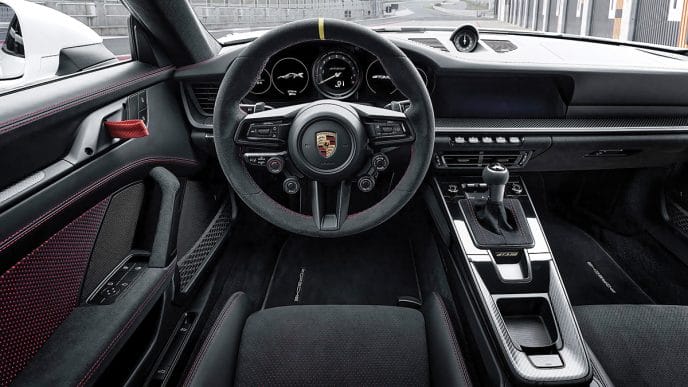Porsche unveils the 2023, 992-generation 911 GT3 RS that is uncompromisingly designed to deliver maximum performance. Combining a naturally aspirated engine with a lightweight structure and track-focused cooling and aerodynamic systems, the latest model is directly linked to the 911 GT3 R racecar. Here are eight main features that help make the new Porsche 911 GT3 RS the most revolutionary street-legal 911 ever built:
Centrally mounted single-piece radiator
Like in the Le Mans-winning 911 RSR and 911 GT3 R, a large, centrally mounted single-piece radiator sits in the car’s nose at an ideal angle. The new layout, replacing the three-radiator arrangement in previous 911 GT3 RS models, frees up space on the sides to allow for improved active aerodynamic elements.
Adjustable aerodynamic pieces
Continuously adjustable elements in the front wing and on the two-part rear wing help in generating twice the downforce compared to the previous model. A drag reduction system (DRS), fitted in a production Porsche for the first time, lets the wings lay flat at the push of a button. When required, the combined wing elements create an aerodynamic deceleration to significantly support the wheel brakes.
Prominent wings

While there are numerous functional aerodynamic pieces in the new Porsche 911 GT3 RS, the most prominent one is the swan-neck-supported rear wing made up of a fixed main wing and another hydraulically adjustable one. The top edge of this wing is slightly higher than the car’s roof — a first for a Porsche production model. In front, the car discards a spoiler in favor of a front splitter that divides the air flowing over and underneath. Side blades direct air outwards.
Air ventilation and redirection systems
Airflow redirected upwards at the front of the car exits via louvered openings behind the front wheels, reducing pressure in the wheel arches. Cooling air coming into the centrally positioned radiator flows out through large nostrils on the hood. Fins on the roof direct the air outwards, ensuring cooler intake temperatures in the rear. Openings in the rear side panels are used exclusively to improve aerodynamics. Rear wheel arches have intakes and side blades to control airflow. More fins at the bottom of the car redirect air away from the car. A rear diffuser cleans the airflow exiting the car.

Performance-focused cockpit
Four rotary knobs, plus a button for the DRS, are placed on the car’s steering wheel. The knobs allow three driving modes to be selected — Normal, Sport, Track. When rotating a knob, the adjustment process is displayed on the instrument cluster. Digital displays on the two seven-inch monitors can show essential information only if desired. Gearshift indicators are placed on both sides of the analog tachometer.
Motorsports dna powertrain
The car’s 4.0-liter naturally aspirated engine now puts out 525 horsepower, thanks to new camshafts with modified profiles, and motorsports-derived single-throttle intake system and rigid valve drive. Matched to the engine is a seven-speed PDK with a shorter gear ratio. These let the new Porsche 911 GT3 RS to accelerate from a standstill to 100 km/h in 3.2 seconds, and to reach a top speed of 296 km/h in seventh gear.
Race-bred brakes and wheels
Aluminum monobloc fixed-caliper brakes with six pistons each and 408-millimeter discs reside in front (the pistons are larger, the discs thicker). At the rear are 380-millimeter discs and four-piston fixed-caliper brakes. Available as an option is the Porsche Ceramic Composite Brake system that has 410-millimeter discs in front and 390-millimeter discs at the rear. In whichever case, the brakes grab forged light-alloy center-lock wheels which are wrapped in road-legal sports tires measuring 275/35 R 20 in front and 335/30 R21 at the rear.

Lightweight components

The new Porsche 911 GT3 RS has doors, front fenders, roof and hood made from lightweight CFRP components, allowing the car to weigh in at only 1,450 kilograms. The standard full bucket seats, along with other interior pieces, are made from CFRP as well. The available Clubsport and Weissach packages further reduce weight.

